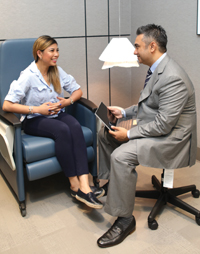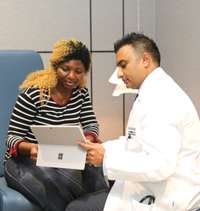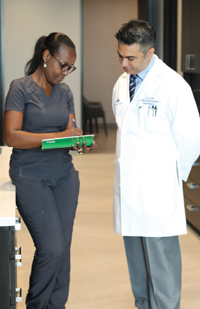Posted on Sep 30, 2019 in
COVER STORY
COVER STORY | Photos by Alisa Murray Photography –

Dr. Sarfraz Aly and Dr. Salman Aly.
When Amy S., an attractive woman in her 50s, noticed the sore on her left foot, she didn’t think it was serious.
Even though she has type 2 diabetes, Amy was often lazy about monitoring her glucose levels. It wasn’t until the sore developed a bad odor that she sought relief with the physicians at Capital Internal Medicine Associates (CIMA) in Sugar Land.
Dr. Salman Aly, experienced in Internal Medicine and Primary Care and specializing in complicated and advanced wound care, examined Amy’s foot and took a swab of the wound. The result shocked Amy: she had no idea she suffered from a deep tissue infection.
Not all foot ulcers in diabetic patients become infected, but Amy thought she had only a small annoying blister and waited six weeks before seeking medical attention. Because of her advanced infection, Dr. Salman Aly consulted an Infectious Disease Specialist, Dr. Sarfraz Aly, who also specializes in complicated wound care. Together they developed a comprehensive and individualized treatment plan to ensure Amy’s foot would heal, avoiding further complications and possible future amputations. Her treatment included an IV infusion with culture specific antibiotics, weekly debridement, specialized wound dressing to promote proper wound healing and a surgical boot that kept weight off of her injured foot. In addition, to further promote Amy’s healing, she underwent hyperbaric oxygen therapy – exposing the wound to 100% oxygen in a pressurized chamber.
Amy’s wound healed, and she learned the value of monitoring her glucose levels.
What is a Diabetic Foot Ulcer?
A diabetic foot ulcer is an open sore or wound that usually is on the ball of the foot or on the bottom of the big toe. Because the wound develops in soft tissue, this makes it easier for infection to reach the muscle and bone.
Even though the sore may not hurt, every ulcer should be seen by an advanced wound care specialist. “Delaying medical attention can lead to serious complications,” said Dr. Sarfraz Aly.
What You Can Do to Prevent Foot Ulcers
- Pay attention to your feet.
- – To see the bottoms of your feet, put a mirror on the floor and hold each foot over it.
- – Rely on a family member for a routine check.
- Wear properly fitting shoes
- Keep toenails trimmed
- Watch your blood sugar levels
- Discuss foot pains with your health care provider
Symptoms
The first sign of a foot ulcer may not be noticed until infection occurs. “If you spot any drainage from your foot, unusual swelling, redness or skin discoloration, especially if your skin has turned dark and dusky, schedule an appointment with your doctor right away,” said Dr. Salman Aly. “In Amy’s case, the odor finally caught her attention.”

Shannon Loughry- Morrow, Maria de Lourdes, Raji Pillai, Shaheena Meghjiani, Javaid Akhtar, Rahila Babar, Lorena Tamez, Tran Huyen Khann Nguyen, Kausar Maknojia-Shaikh and Sarosh Din.
Be Aware
Neuropathy: Foot problems can be triggered by nerve damage called neuropathy. Nerve damage can cause tingling, pain or weakness in the foot. Nerve damage can lessen your ability to feel pain, heat or cold; therefore, you may not know that you are injured, have a blister or be aware that there is a problem until your skin is infected.
Poor Circulation: Poor circulation (blood flow) can weaken the foot’s ability to fight infection. Diabetes causes blood vessels in the foot and leg to narrow and harden. Drs. Aly advise patients to keep their blood pressure and cholesterol under control and not to smoke. Smoking affects small blood vessels and causes arteries to harden faster.
Osteomyelitis: Osteomyelitis is an infection of the bone, usually caused by a staph or strep bacteria. Symptoms include fever, fatigue and nausea, as well as redness, tenderness or swelling in the area of the infection.
Amputation: People with diabetes are more likely to have a foot or leg amputated than other people. Many diabetic patients have peripheral arterial disease (PAD) which reduces blood flow to their feet. Serious problems can lead to infection and ultimately, amputation. CIMA works closely with patients to prevent this life-changing outcome.
Treatments

Jessica Sanchez and Dr. Sarfraz Aly.
Dr. Sarfraz Aly and Dr. Salman Aly recommend the earliest treatment possible. Working together, these two specialists determine the best treatment plan to match each patient.
Not all infections are treated the same. Depending on the ulcer, a culture of the wound may need to be taken to learn if an infection is present, and if so, what type. Unhealthy tissue may need to be removed from the wound, which also promotes healing.
Walking on an ulcer can make it worse, often increasing its size and forcing the infection to move deeper into the foot. Drs. Aly advise patients to keep off their feet. They may recommend a special shoe, a brace or a cast, usually covered by Medicare and other insurance providers.
Other options include advanced therapies, such as hyperbaric oxygen therapy and skin substitute grafts.
Advice

Rosie Anderson and Dr. Salman Aly.
Both doctors emphasize the importance of foot care. Maintaining good diabetes control and maintaining a healthy diet are vital because high blood glucose levels make it hard to fight infection. “If you develop foot problems, make an appointment with us right away. Do not wait. Avoiding foot problems can prevent serious complications,” they emphasized.
Advanced wound care specialists Dr. Sarfraz Aly and Dr. Salman Aly work as a cohesive team. “Because we know how dangerous foot ulcers can be, our focus is on prevention.”
Compassion, Commitment, Connection
Using the most advanced treatments for patients, Dr. Salman Aly and Dr. Sarfraz Aly focus on staying current with cutting-edge research and technology. “At CIMA, we care for patients suffering from common illnesses to chronic conditions, as well as provide vitamin infusions, IV hydration and aesthetic services, such as Botox and injectable fillers. We take care of the whole person.”

Rose Sangona and Dr. Sarfraz Aly.
Dr. Sarfraz Aly and Dr. Salman Aly knew the logical step to combine their expertise, for the optimum in patient care, was to co-found Capital Advanced Wound Care (CAWC). This clinic specializes not only in diabetic wounds and pressure ulcers, but venous stasis ulcers, vascular ulcers, non-healing surgical wounds, complex soft tissue wounds, traumatic wounds, infected wounds, chronic wounds and burns.
CIMA, CIDA and CAWC are an integrated medical community of specialists who focus on excellence in patient care. Their mission is founded on the ideals of compassion, commitment, and connection.
“We have a deep sense of compassion and see our patients as individuals,” emphasized Dr. Sarfraz Aly and Dr. Salman Aly. “Our commitment to patients is unrivaled with our needs-driven medical clinic. With pride, we build relationships through connection to our patients and our community. Above all, we are always here for our patients.”


 <
<










